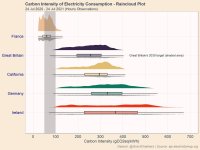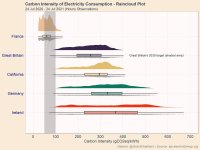lpetrich
Contributor
Many present-day sailboats and sailing ships are  Motorsailer ones, with both an engine and sails. One uses the engine when one is becalmed or has wrong-way wind or is in a harbor.
Motorsailer ones, with both an engine and sails. One uses the engine when one is becalmed or has wrong-way wind or is in a harbor.
I'm very skeptical of how useful sails and Magnus-effect cylinders will be for very large ships. That is because of the square-cube law. To propel the ship, one needs an area proportional to the ship's mass M, and that gives a size of M^(1/2). Since the size of the ship L is related to its mass as M ~ L^3, the necessary sail size is thus roughly L^(3/2).
Let's look at the Ever Given, a large container ship that became (in)famous for getting stuck in the Suez Canal. Its displacement (mass) is some 267,000 metric tons.
Ever Given, a large container ship that became (in)famous for getting stuck in the Suez Canal. Its displacement (mass) is some 267,000 metric tons.
Scaling up from the Cutty Sark, the Ever Given would require nearly 400 thousand square meters of sail. Let's see how many masts it has space for. The CS has a mast spacing of 16 meters, and scaling to the EG's length, 400 meters, means 24 masts. Each of CS's masts had about 1000 square meters of sail, and 24 masts of that mean 24,000 square meters total. Very inadequate.
If all that sail was in a single square kite sail, that sail would be 600 m * 600 m. For comparison, let us consider EG's deck area. Estimating it as length * beam (60 m for the EG), I find 24,000 square meters, 1/17 of the necessary sail area. The CS has 700 m^2 of deck area, 1/4 of its sail area.
One can do similar calculations for large cruise ships. Oasis-class cruise ship has the current largest ship, the Symphony of the Seas. These ships weigh in at about 100,000 metric tons, meaning that they would need less sail than large container ships like the Ever Given. They would need 143,000 square meters of sail, nearly (400 m)^2. That's a bit longer than these ships, typically 360 m.
Oasis-class cruise ship has the current largest ship, the Symphony of the Seas. These ships weigh in at about 100,000 metric tons, meaning that they would need less sail than large container ships like the Ever Given. They would need 143,000 square meters of sail, nearly (400 m)^2. That's a bit longer than these ships, typically 360 m.
With 20 masts as 16 m / mast and 1000 m^3 of sail / mast, one gets 20,000 m^2, 1/7 the necessary area.
So I don't see how sails or spinning cylinders will work for very large ships.
I'm very skeptical of how useful sails and Magnus-effect cylinders will be for very large ships. That is because of the square-cube law. To propel the ship, one needs an area proportional to the ship's mass M, and that gives a size of M^(1/2). Since the size of the ship L is related to its mass as M ~ L^3, the necessary sail size is thus roughly L^(3/2).
Let's look at the
Scaling up from the Cutty Sark, the Ever Given would require nearly 400 thousand square meters of sail. Let's see how many masts it has space for. The CS has a mast spacing of 16 meters, and scaling to the EG's length, 400 meters, means 24 masts. Each of CS's masts had about 1000 square meters of sail, and 24 masts of that mean 24,000 square meters total. Very inadequate.
If all that sail was in a single square kite sail, that sail would be 600 m * 600 m. For comparison, let us consider EG's deck area. Estimating it as length * beam (60 m for the EG), I find 24,000 square meters, 1/17 of the necessary sail area. The CS has 700 m^2 of deck area, 1/4 of its sail area.
One can do similar calculations for large cruise ships.
With 20 masts as 16 m / mast and 1000 m^3 of sail / mast, one gets 20,000 m^2, 1/7 the necessary area.
So I don't see how sails or spinning cylinders will work for very large ships.


